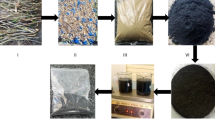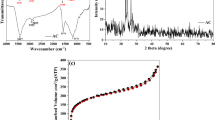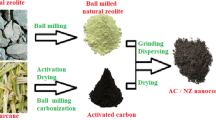Abstract
Recycling cotton waste derived from the textile industry was used as a low-cost precursor for the elaboration of an activated carbon (AC) through carbonization and zinc chloride chemical activation. The AC morphological, textural, and surface chemistry properties were determined using different analytical techniques including Fourier transform infrared, temperature programmed desorption-mass spectroscopy, nitrogen manometry and scanning electron microscopy. The results show that the AC was with a hollow fiber structure in an apparent diameter of about 6.5 μm. These analyses indicate that the AC is microporous and present a uniform pore size distributed centered around 1 nm. The surface area and micropore volume were 292 m2.g−1 and 0.11 cm3.g−1, respectively. Several types of acidic and basic oxygenated surface groups were highlighted. The point of zero charge (pHPZC) of theca was 6.8. The AC performance was evaluated for the removal of Alizarin Red S (ARS) from aqueous solution. The maximum adsorption capacity was 74 mg.g−1 obtained at 25 °C and pH = 3. Kinetics and equilibrium models were used to determine the interaction nature of the ARS with the AC. Statistical tools were used to select the suitable models. The pseudo-second order was found to be the most appropriate kinetic model. The application of two and three isotherm models shows that Langmuir–Freundlich (n = 0.84, K = 0.0014 L.mg−1, and q = 250 mg.g−1) and Sips (n = 0.84, K = 0.003 L.mg−1, and q = 232.6 mg.g−1) were the suitable models. The results demonstrated that cotton waste can be used in the textile industry as a low-cost precursor for the AC synthesis and the removal of anionic dye from textile wastewater.










Similar content being viewed by others
References
Albadarin AB, Mangwandi C (2015) Mechanisms of Alizarin Red S and methylene blue biosorption onto olive stone by-product: isotherm study in single and binary systems. J Environ Manag 164:86–93
Ali M, Courtenay P (2014) Evaluating the progress of the UK’s material recycling facilities: a mini review. Waste Manag Res 12:1149–1157
Almasian A, Olya ME, Mahmoodi NM (2015) Synthesis of polyacrylonitrile/polyamidoamine composite nanofibers using electrospinning technique and their dye removal capacity. J Taiwan Inst Chem Eng 49:119–128
Altıntıg E, Arabacı G, Altundag H (2016) Preparation and characterization of the antibacterial efficiency of silver loaded activated carbon from corncobs. Surface & Coatings Technology. doi:10.1016/j.surfcoat.2016.06.077
Antal MJ (1984) Biomass pyrolysis, in K.W. Boer and J.A. Duffy (Eds.). Advances in Solar Energy. (3), 175–255
Azquez BL, Calero G, Ronda M, Tenorio A, Martín-Lara G (2014) Study of kinetics in the biosorption of lead onto native and chemically treated olive stone. J Ind Eng Chem 20:2754–2760
Bazrafshan A, hajati S, Ghaedi M (2015) Regenerable Zn(OH)2 nanoparticle-loaded activated carbon for the ultrasound-assisted removal of malachite green. Optimization, isotherm and kinetics, RSC Adv 5:79119–79128
Belhechemi M, Jeguirim M, Limousy L, Addoun F (2014) Comparison of NO2 removal using date pits activated carbon and modified commercialized activated carbon via different preparation methods: effect of porosity and surface chemistry. Chem Eng J 253:121–129
Ben Hamissa AM, Lodi A, Seffen M, Finocchio E, Botter R, Converti A (2010) Sorption of Cd(II) and Pb(II) from aqueous solutions onto Agave americana fibers. Chem Eng J 159:67–74
Crini G (2008) Kinetic and equilibrium studies on the removal of cationic dyes from aqueous solution by adsorption onto a cyclodextrin polymer. Dyes Pigments 77:415–426
Dongqing Z, **xue L, Zarraz MP, Richard M, Yu L, Soon K, Wun JN (2016) Characterization of microbial communities in wetland mesocosms receiving caffeine-enriched wastewater. Environ Sci Pollut Res 23:1–14
Dubinin MM (1960) The potential theory of adsorption of gases and vapors for adsorbents with energetically nonuniform surfaces. Chem Rev 60:235–241
Ekrami E, Dadashian F, Soleimani M (2014) Waste cotton fibers based activated carbon: optimization of process and product characterization. Fibers and Polymers 15:1855–1864
Fadi AM, Bernard L (2009) Effect of the adsorbate (Bromacil) equilibrium concentration in water on its adsorption on powdered activated carbon. Part 2: kinetic parameters. J Hazard Mater 170:754–762
Fan L, Zhang y, Li X, Luo L, Lu F, Qiu H (2012) Removal of Alizarin Red from water environment using magnetic chitosan with Alizarin Red as imprinted molecules. Colloids Surf B: Biointerfaces 91:250–257
Fayazi M, Ghanei-Motlagh M, Taher MA (2015) The adsorption of basic dye (Alizarin Red S) from aqueous solution onto activated carbon-Fe2O3 nano-composite: kinetic and equilibrium studies. Mater Sci Semicond Process 40:35–43
Foo KY, Hameed BH (2010) An overview of dye removal via activated carbon adsorption process. Desalin and Water Treat 19:255–274
Freundlich H (1906) Over the adsorption in solution. Z Phys Chem 57:384–470
Fritz W, Schluender EU (1974) Simultaneous adsorption equilibrium of organic solutes in dilute aqueous solution on activated carbon. Journal of Chemical Engineering Science 29:279–1282
Gautam RK, Mudhoo A, Chattopadhyaya MC (2013) Kinetic, equilibrium, thermodynamic studies and spectroscopic analysis of Alizarin Red S removal by mustard husk. J Environ Chem Eng 1:1283–1291
Ghouma I, Jeguirim M, Dorge S, Limousy L, Matei GC, Ouederni A (2015) Activated carbon prepared by physical activation of olive stones for the removal of NO2 at ambient temperature. Comptes Rendus Chimie 18:63–74
Gimbert F, Crini NM, Renault F, Badot PM, Crini G (2008) Adsorption isotherm models for dye removal by cationized starch-based material in a single component system: error analysis. J Hazard Mater 157:34–46
Guo YP, Rockstraw DA (2006) Physical and chemical properties of carbons synthesized from xylan, cellulose, and Kraft lignin by H3PO4 activation. Carbon 44:1464–1475
Gupta VK, Suhas (2009) Application of low-cost adsorbents for dye removal—a review. J Environ Manag 90:2313–2342
Gupta VK, Gupta b, Rastogi A, Agarwal S, Nayak A (2011) A comparative investigation on adsorption performances of mesoporous activated carbon prepared from waste rubber tire and activated carbon for a hazardous azo dye–Acid Blue 113. J Hazard Mater 186:891–901
Gurudatt K, Tripathi VS, Sen AK (1999) Adsorbent carbon fabrics: new generation armour for toxic chemicals. Def Sci J 47:239–250
Han X, Wang W, Ma X (2011) Adsorption characteristics of methylene blue onto low cost biomass material lotus leaf. Chem Eng J 171:1–8
Haule LV, Carr MC, Rigout M (2014) Investigation into the removal of an easy-care crosslinking agent from cotton and the subsequent regeneration of lyocell-type fibres. Cellulose 21(3):2147–2156
Haule LV, Carr CM, Rigout M (2016) Investigation into the supramolecular properties of fibres regenerated from cotton based waste garments. Carbohydr Polym 144:131–139
Hinz C (2001) Description of sorption data with isotherm equations. Geoderma 99:225–243
Ho YS, McKay G (1999) Pseudo-second order model for sorption processes. Process Biochem 34:451–465
Javad Z, Neda A, Maryam B, Gholamhasan A (2014) Multi-response optimization using Taguchi design and principle component analysis for removing binary mixture of alizarin red and alizarin yellow from aqueous solution by nano c-alumina. Spectrochim Acta A Mol Biomol Spectrosc 126:291–300
Jie C, Xunwen S, Canhui L, Zehang Z, ** Y (2016) Water-soluble cellulose acetate from waste cotton fabrics and the aqueous processing of all-cellulose composites. Carbohydrate Polymers. In Press
Jieying Z, Quanlin Z, Zhengfang Y (2014) Preparation and characterization of activated carbon fiber (ACF) from cotton woven waste. Appl Surf Sci 299:86–91
Kennedy LJ, Vijaya JJ, Kayalvizhi K, Sekaran G (2007) Adsorption of phenol from aqueous solutions using mesoporous carbon prepared by two-stage process. Journal of Chemical Engineering 132:279–287
Kesraoui A, Moussa A, Ben Ali G, Seffen M (2015) Biosorption of alpacide blue from aqueous solution by lignocellulosic biomass: Luffa cylindrica fibers. Environmental Science and Pollution Research, 1–9
Koopal LK, van Riemsdijk WH, de Wit JCM, Benedetti MF (1994a) Analytical isotherm equations for multicomponent adsorption to heterogeneous surfaces. J Colloid Interface Sci 166:51–60
Kumar DB, Smaïl K (2010) Étude cinétique et thermodynamique de l’adsorption d’un colorant basique sur la sciure de Bois. Revue des sciences de l'eau Journal of Water Science 24:131–144
Lagergren S (1998) About the theory of so-called adsorption of soluble substances. K Svenska Vetenskapsakad Handl 24:1–39
Langmuir I (1918) The adsorption of gases on plane surfaces of glass, mica and platinum. J Am Chem Soc 40:1361–1403
Li FT, Yang H, Zhao Y, Xu R (2007) Novel modification pectin for heavy metal adsorption. Chin Chem Lett 18:325–328
Liang S, Guo X, Feng N, Tian Q (2010) Isotherms, kinetics and thermodynamic studies of adsorption of Cu2+ from aqueous solutions by Mg2+/K+ type orange peel adsorbent. J Hazard Mater 174:756–762
Liou TH (2010) Development of mesoporous structure and high adsorption capacity of biomass-based activated carbon by phosphoric acid and zinc chloride activation. Chem Eng J 158:129–142
Loelovich M (2008) Cellulose as a nanosructured polymer: a short review. Bioressources 3:1403–1418
Marchon B, Carrazza J, Heinemann H, Somorjai GA (1988) TPD and XPS studies of O2, CO2, and H2O adsorption on clean polycrystalline graphite. Carbon 26:507–514
Mardini FA, Legube B (2009) Journal of hazardous materials. J Hazard Mater 170:744–753
Martynas T, Edvinas K, Viktoras R, Rainer H, Violeta K, Inga S, Dainius M (2013) Chemical degradation of various textile dyes as wastewater pollutants under dielectric barrier discharge plasma treatment. Engineering Journal 229:9–19
Mehrorang G, Sh H, Syamak NK, Reza S, Ali D, Behnaz B (2012) Comparison of silver and palladium nanoparticles loaded on activated carbon for efficient removal of methylene blue: kinetic and isotherm study of removal process. Powder Technol 228:18–25
Nasiri Azad F, Ghaedi M, Ddashtian K, Montazerozohori M, Hajati S, Alipanahpour E (2015) Preparation and characterization of MWCNTs functionalized by N-(3-Nitrobenzylidene)-N′-trimethoxysilylpropyl-ethane-1, 2-diamine for the removal of aluminum (III) ions via complexation with ferrochrome cyanine R: spectrophotometric detection and optimization. RSC Adv 5:61060–61069
Ncibi MC, Mahjoub B, Seffen M (2006) Studies on the biosorption of textile dyes from aqueous solutions using Posidonia oceanica (L.) leaf sheath fibres. Adsorpt Sci Technol 24:461–473
Otake Y, Jenkins RG (1993) Characterization of oxygen-containing surface complexes created on a microporous carbon by air and nitric acid treatment. Carbon 31:109–121
Ouchi A, Toida T, Kumaresan S, Ando W, Kato J (2010) A new methodology to recycle polyester from fabric blends with cellulose. Cellulose 17:215–222
Parra S, Sarria V, Maloto, Periner P, Pulgarin C (2004) Photocatalytic degradation of atrazine using suspended and supported TiO2 J. Appli Catal B: Environ 51:107–116
Pastor AC, Rodriguez-Reinoso F, Marsh H, Martinez MA (1999) Preparation of activated carbon cloths from viscous rayon. Part I. Carbonization procedures. Carbon 37:1275–1283
Pirillo S, Ferreiraa ML, Ruedaa EH (2009) The effect of pH in the adsorption of Alizarin and Eriochrome Blue Black R onto iron oxides. J Hazard Mater 168:168–178
Plazinski W, Dziuba J, Rudzinski W (2013) Modeling of sorption kinetics: the pseudo-second order equation and the sorbate intraparticle diffusivity. Journal of the international Adsorption society 19:1055–1064
Radke CJ, Prausnitz JM (1972) Adsorption of organic solutions from dilute aqueous solution on activated carbon. Ind Eng Chem Fundam 11:445–451
Ravindra KG, Ackmez M, Mahesh CC (2013) Kinetic, equilibrium, thermodynamic studies and spectroscopic analysis of Alizarin Red S removal by mustard husk. Journal of Environmental Chemical Engineering 4:1283–1291
Redlich O, Peterson DL (1959) A useful adsorption isotherm. J Phys Chem 57:1024–1031
Rehman R, Mahmud T (2013) Sorptive elimination of Alizarin Red-S dye from water using Citrullus lanatus peels in environmentally benign way along with equilibrium data modeling. Asian J Chem 25:5351–5356
Roosta M, Ghaedi M, Mohammadi M (2014) Removal of Alizarin Red S by gold nanoparticles loaded on activated carbon combined with ultrasound device: optimization by experimental design methodology. Powder Technol 267:134–144
Salam MA, El-Shishtawy RM, Obaid AY (2014) Synthesis of magnetic multi-walled carbon nanotubes/magnetite/ chitin magnetic nanocomposite for the removal of Rose bengal from real and model solution. J Ind Eng Chem 20:3559–3567
Samusolomon J, Devaprasath PM (2011) Removal of Alizarin Red S (dye) from aqueous media by using Cynodon dactylon as an adsorbent. J Chem Pharm Res 5:478–490
Sips R (1948) On the structure of a catalyst surface. J Chem Phys 16:490–495
Sylvie B, Nathalie A, Catherine B, Marie FP, Jose MLC, Olivier T (2005) Study of heterogeneous suspensions: a new quantitative approach coupling laser granulometry and UV–vis spectrophotometry. Colloids Surf A Physicochem Eng Asp 262:242–250
Tzvetkov G, Mihaylova S, Stoitchkova K, Tzvetkov P, Spassov T (2016) Mechanochemical and chemical activation of lignocellulosic material to prepare powdered activated carbons for adsorption applications. Powder Technol. doi:10.1016/j.powtec.2016.05.033
Wanassi B, Azzouz B, Ben-Hassen M (2016) Value-added waste cotton yarn: optimization of recycling process and spinning of reclaimed fibers. Ind Crop Prod 87:27–32
Weber WJ, Morris JC (1963) Kinetics of adsorption on carbon from solution. J Sanit Eng Div Am Soc Civ Engs 89:SA2–S31
Zaharia C, Suteu D (2012) Textile organic dyes-characteristics, polluting effects and separation/elimination procedures from industrial effluents—a critical overview. T. Puzyn (Ed.) Organic Pollutants Ten Years After the Stockholm Convention-Environmental and Analytical Update, InTech, Croatia, 472
Zahid M, Sabir H, Tanvir A, Habibullah N, Muhammad I, Azeem K, Muhammad A, Fabrice ML (2016) Use of RSM modeling for optimizing decolorization of simulated textile wastewater by Pseudomonas aeruginosa strain ZM130 capable of simultaneous removal of reactive dyes and hexavalent chromium. Environmental Science and Pollution Research. 1–16
Zainab ZI, Ali RT (2016) Recycled medical cotton industry waste as a source of biogas recovery. J Clean Prod 112:4413–4418
Zhuang Q-L, Kyotany T, Tomita A (1994) DRIFT and TK/TPD analyses of surface oxygen complexes formed during carbon gasification. Energy and Fuels 8:714–718
Author information
Authors and Affiliations
Corresponding author
Additional information
Responsible editor: Philippe Garrigues
Rights and permissions
About this article
Cite this article
Wanassi, B., Hariz, I.B., Ghimbeu, C.M. et al. Carbonaceous adsorbents derived from textile cotton waste for the removal of Alizarin S dye from aqueous effluent: kinetic and equilibrium studies. Environ Sci Pollut Res 24, 10041–10055 (2017). https://doi.org/10.1007/s11356-017-8410-1
Received:
Accepted:
Published:
Issue Date:
DOI: https://doi.org/10.1007/s11356-017-8410-1




